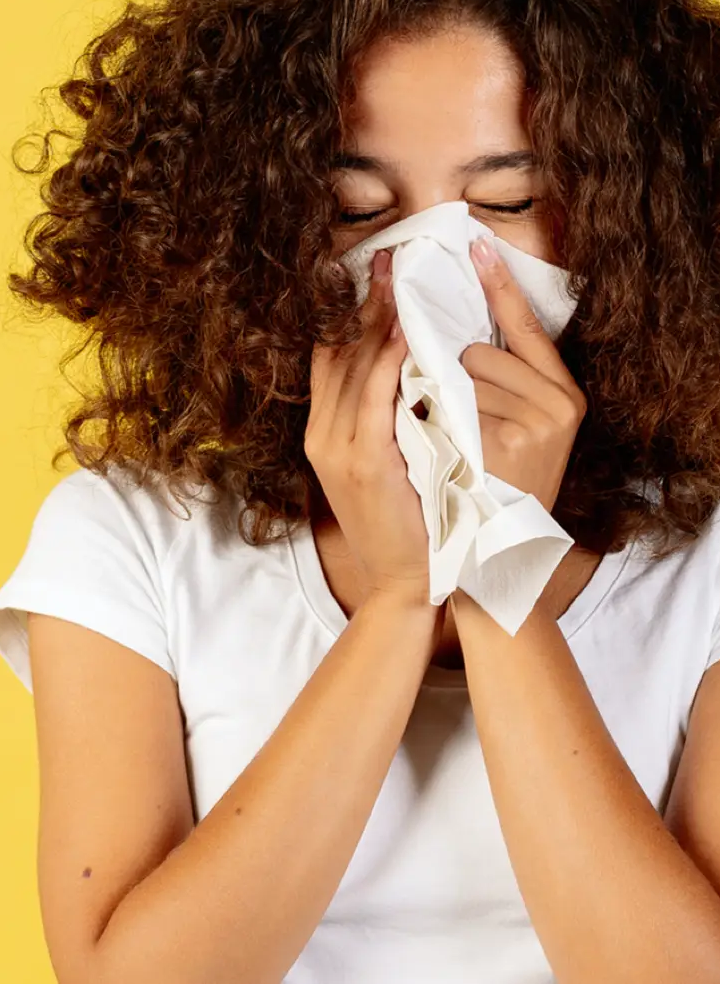Telling the Difference between COVID-19, Colds and Allergies
Learn the different symptoms, risks, and prevention options between cold, flu, and COVID-19 viruses.

In a time when getting sick might mean COVID-19, you may be questioning your symptoms more than you used to. As the coronavirus shares so many symptoms with the common cold and allergies, it can be hard to tell them apart. We’ll help you get a sense of what’s causing your symptoms so you can respond appropriately.
STEP 1: Is it COVID-19?
Allergies, the common cold, and COVID-19 can have many symptoms in common. All three of these ailments can cause coughing, fatigue, sneezing, sore throat, a runny or stuffy nose, and loss of taste or smell. Other COVID-19 symptoms to look out for are fever, headache, body aches and pains, diarrhea, sore throat, skin rash, eye irritation, and discoloration of fingers or toes. If you have any of these symptoms, the best first step is to take a COVID-19 test. Thankfully, rapid antigen test kits are available to help determine if your symptoms are from COVID-19 or something else. These tests usually function best when taken within the first few days of developing symptoms. If your test is positive, you’ll know you have COVID-19, and you can respond accordingly. If your test is negative, there’s a good chance that your symptoms are due to something like a cold or allergies. However, keep in mind that no test is 100% accurate. Consider using precautions like hand washing, social distancing, and face masks just in case. If you’ve tested negative and are wondering what you might have, looking at the symptoms of COVID-19, a cold, and allergies can help.
STEP 2: Using Symptoms to Tell the Difference
COVID-19 can present with a wide array of symptoms or with no symptoms at all. It’s not possible to know with complete certainty what you have just by looking at the symptoms, but it can help you make a more educated guess. Talk to a healthcare professional if you’re concerned and need help treating your symptoms.
Common Cold vs. COVID-19
Symptoms of a Cold: The common cold and COVID-19 are, in many cases, indistinguishable by their symptoms. However, there are a few indicators that can suggest you’re more likely experiencing a cold. While sneezing can happen in COVID-19, it’s more likely to occur with a cold. The cough in COVID-19 is usually dry, so a wet cough could be an indicator in your favor.
Symptoms of COVID-19: Muscle aches, fatigue, fever, and a loss of taste or smell are possible with a cold, but they’re more likely to be due to COVID-19. Diarrhea, nausea and vomiting are never caused by a cold. If you have these symptoms, COVID-19 might be the cause.
Allergies vs. COVID-19
Symptoms of Allergies: Some of the most common symptoms of allergies are sneezing and itchiness of the eyes, nose, mouth or inner ear. (A runny nose is common too, but it’s also common with COVID-19.) If you’re sneezing and your eyes, nose, mouth or inner ear is itchy, it is more likely caused by allergies.
Symptoms shared: Other symptoms shared by allergies and COVID-19 include coughing, tiredness, and pink eye.
COVID-19 Symptoms: A sore throat is possible with allergies, but is more likely a sign of COVID-19. If you have muscle aches, fever, diarrhea, nausea, or vomiting, these are not symptoms of allergies. You may have COVID-19.
Step 3: Treatment
If you need help treating COVID-19, a cold, or allergies, WellNow is here for you. You can talk to a medical provider at any time of day or night using our virtual care service. Our urgent care centers are available to treat a wide range of illnesses and injuries. Allergists are available at some locations to help you identify your triggers and find the best treatment for you. Whenever you need us, WellNow is here to help you feel better.
Treating COVID-19
If you test positive for COVID-19, always follow the self-isolation guidelines of your state. Take all recommended precautions to avoid spreading the illness to others. While you recover, get plenty of rest, drink lots of water, and eat healthy foods. Symptoms can be relieved using many of the same medications you would use for a cold. Pain relievers can help with symptoms like headache and muscle pain. Decongestants and saline rinses can provide relief from a stuffy, runny nose.If you have chest pain, confusion, difficulty breathing, or loss of speech or mobility, contact your health provider right away.Treating a Cold
While colds are contagious, you are not required to isolate. Get lots of rest, and take reasonable precautions against spreading your cold. Colds are caused by viruses, and cannot be treated with medications like antibiotics. Pain relievers, decongestants, and saline irrigation can help reduce your symptoms. These remedies can be purchased over the counter. In most cases, your cold will clear up on its own within ten days.Treating Allergies
If your symptoms are being triggered by allergies, there are several ways to start feeling better. If possible, you should avoid your allergy triggers. If you don’t know what you’re allergic to, an allergist can help you identify it with allergy testing. There are also medications, such as antihistamines, you can take to relieve your symptoms. If these methods fail to help and your allergies are severe, immunotherapy can help by gradually exposing you to your allergen over time.
Schedule a visit
Start a virtual visit
Information contained in this blog is for informational or educational purposes only and does not substitute professional medical advice or consultations with healthcare professionals. The content is not meant to be complete or exhaustive or to apply to any specific individual's medical condition. Always refer to the personalized information given to you by your doctor or contact us directly.
